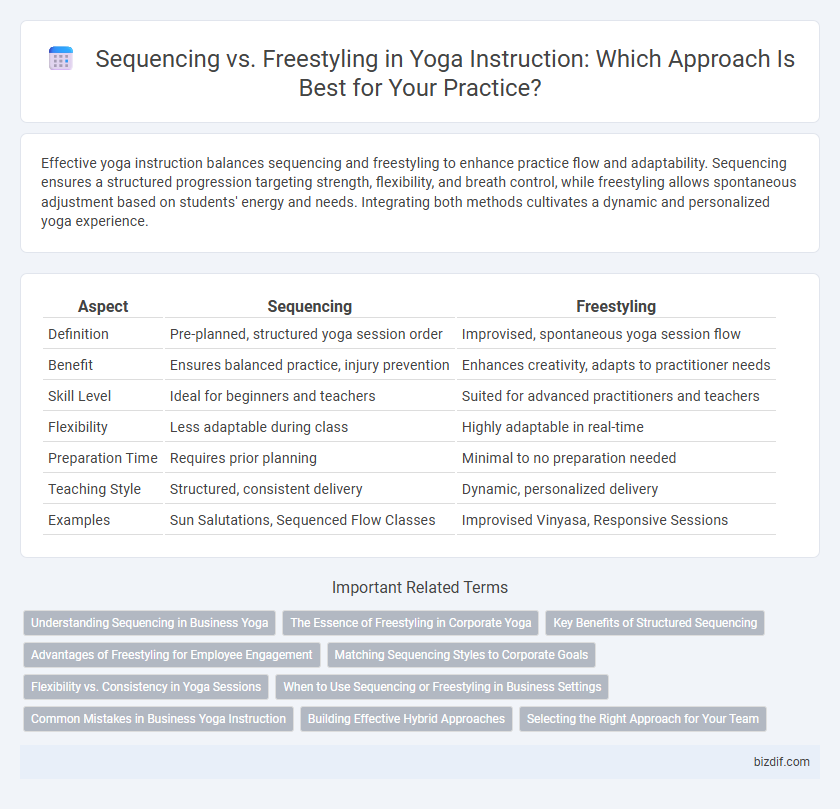Effective yoga instruction balances sequencing and freestyling to enhance practice flow and adaptability. Sequencing ensures a structured progression targeting strength, flexibility, and breath control, while freestyling allows spontaneous adjustment based on students' energy and needs. Integrating both methods cultivates a dynamic and personalized yoga experience.
Table of Comparison
| Aspect | Sequencing | Freestyling |
|---|---|---|
| Definition | Pre-planned, structured yoga session order | Improvised, spontaneous yoga session flow |
| Benefit | Ensures balanced practice, injury prevention | Enhances creativity, adapts to practitioner needs |
| Skill Level | Ideal for beginners and teachers | Suited for advanced practitioners and teachers |
| Flexibility | Less adaptable during class | Highly adaptable in real-time |
| Preparation Time | Requires prior planning | Minimal to no preparation needed |
| Teaching Style | Structured, consistent delivery | Dynamic, personalized delivery |
| Examples | Sun Salutations, Sequenced Flow Classes | Improvised Vinyasa, Responsive Sessions |
Understanding Sequencing in Business Yoga
Understanding sequencing in business yoga enhances class flow by strategically organizing poses to maximize physical benefits and minimize injury risk. Effective sequencing considers energy levels, muscle groups, and breathing techniques to create a balanced, coherent session that meets diverse client needs. This structured approach differentiates professional yoga instruction, elevating client satisfaction and retention in corporate wellness programs.
The Essence of Freestyling in Corporate Yoga
Freestyling in corporate yoga emphasizes adaptability and responsiveness to employees' immediate physical and mental needs, fostering a dynamic practice tailored to varying stress levels and energy fluctuations throughout the workday. Unlike rigid sequencing, freestyling cultivates mindfulness and presence, encouraging participants to listen to their bodies and engage in movements that best support their current state. This flexible approach enhances overall well-being and productivity by promoting personalized stress relief and increased body awareness in fast-paced corporate environments.
Key Benefits of Structured Sequencing
Structured sequencing in yoga enhances flow, ensuring logical progression that targets muscle groups systematically for balanced strength and flexibility. It reduces injury risk by gradually increasing intensity and complexity, supporting safe practice improvements. This method also improves mental focus and clarity by establishing predictable patterns that deepen practitioner awareness.
Advantages of Freestyling for Employee Engagement
Freestyling in yoga instruction fosters greater employee engagement by encouraging creativity and personal expression, which enhances motivation and satisfaction. It allows instructors to adapt sequences dynamically based on the energy and feedback of the group, promoting a more inclusive and responsive environment. This flexible approach cultivates stronger connections between employees and the practice, boosting overall participation and morale.
Matching Sequencing Styles to Corporate Goals
Matching sequencing styles in yoga instruction to corporate goals enhances employee wellness programs by aligning practice structure with organizational objectives such as stress reduction, productivity, or team building. Sequenced classes, like Vinyasa flow, provide predictable, goal-oriented sessions ideal for fostering focus and consistency, while freestyle formats encourage creativity and adaptability, promoting mental flexibility and innovation. Selecting the appropriate sequencing style ensures yoga sessions effectively support the company's wellness strategy and employee engagement levels.
Flexibility vs. Consistency in Yoga Sessions
Sequencing in yoga offers consistent structure, allowing practitioners to progressively build strength and flexibility through thoughtfully planned poses aligned with anatomical principles. Freestyling promotes flexibility by encouraging spontaneous adaptation to the body's immediate needs, enhancing mindfulness and creativity in movement. Balancing sequencing with freestyling cultivates both reliable progression and personalized responsiveness, optimizing overall yoga practice effectiveness.
When to Use Sequencing or Freestyling in Business Settings
Sequencing in yoga instruction ensures structured progression and consistency, making it ideal for corporate wellness programs where predictable outcomes are prioritized. Freestyling offers adaptability and responsiveness, benefiting small business workshops that require personalized approaches to diverse participant needs. Selecting sequencing or freestyling depends on client goals, session duration, and the level of participant experience within the business setting.
Common Mistakes in Business Yoga Instruction
Common mistakes in business yoga instruction often stem from poor sequencing or excessive freestyling, leading to inconsistent class flow and reduced student engagement. Overreliance on freestyling can disrupt the logical progression of poses, causing confusion and potential injury, while rigid sequencing without flexibility may ignore individual student needs. Effective teachers balance structured sequencing with adaptive freestyling to enhance safety, maintain class cohesion, and support optimal learning outcomes.
Building Effective Hybrid Approaches
Combining structured sequencing and freestyling in yoga instruction enhances class adaptability and student engagement by balancing predictability with creativity. Effective hybrid approaches integrate foundational poses with spontaneous flow, supporting progressive skill development while encouraging intuitive movement exploration. This method optimizes class dynamics and addresses diverse practitioner needs, fostering a holistic yoga experience.
Selecting the Right Approach for Your Team
Choosing between sequencing and freestyling in yoga instruction depends on your team's experience and goals; sequencing ensures structured progression and safety, ideal for beginners or therapeutic sessions. Freestyling encourages creativity and spontaneity, benefiting advanced practitioners who thrive on adapting poses to their energy and group dynamics. Assess your team's skill level, cohesion, and objectives to determine the most effective instructional approach that maximizes engagement and progress.
Sequencing vs Freestyling Infographic

 bizdif.com
bizdif.com